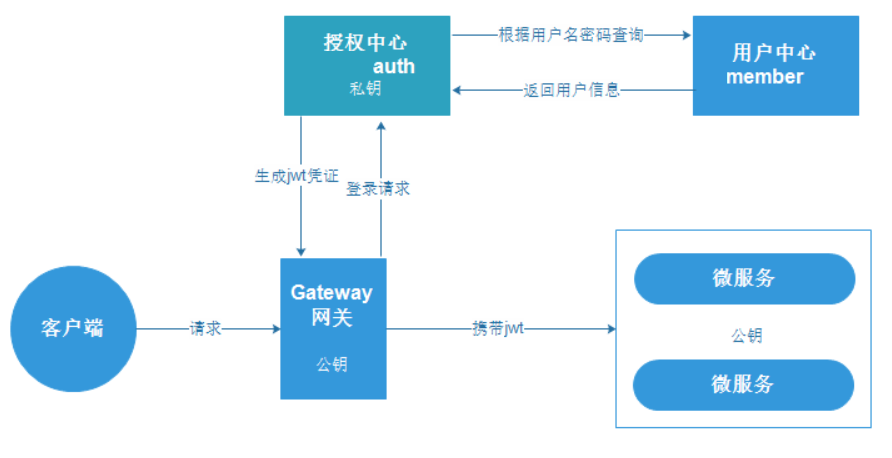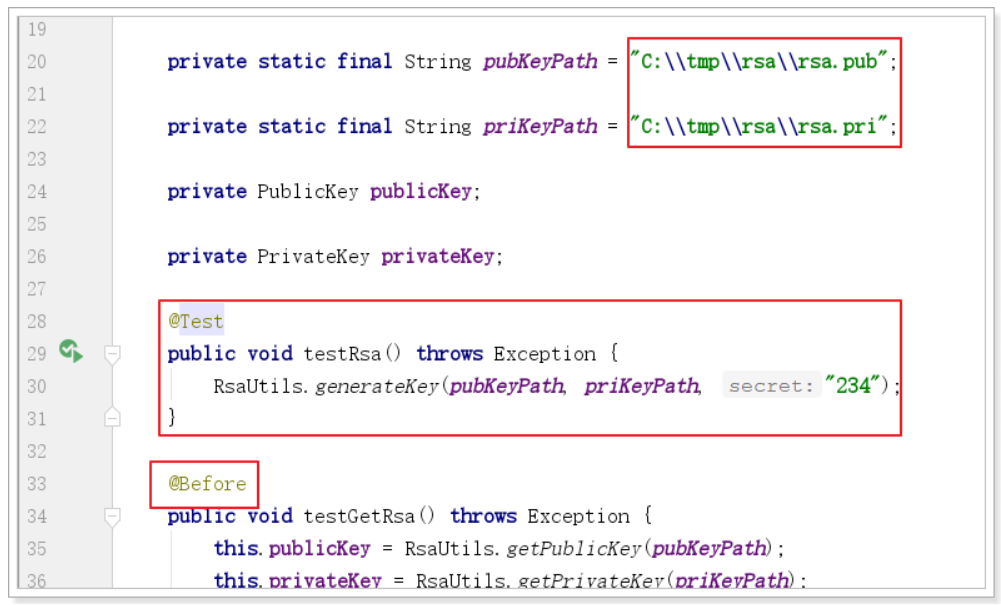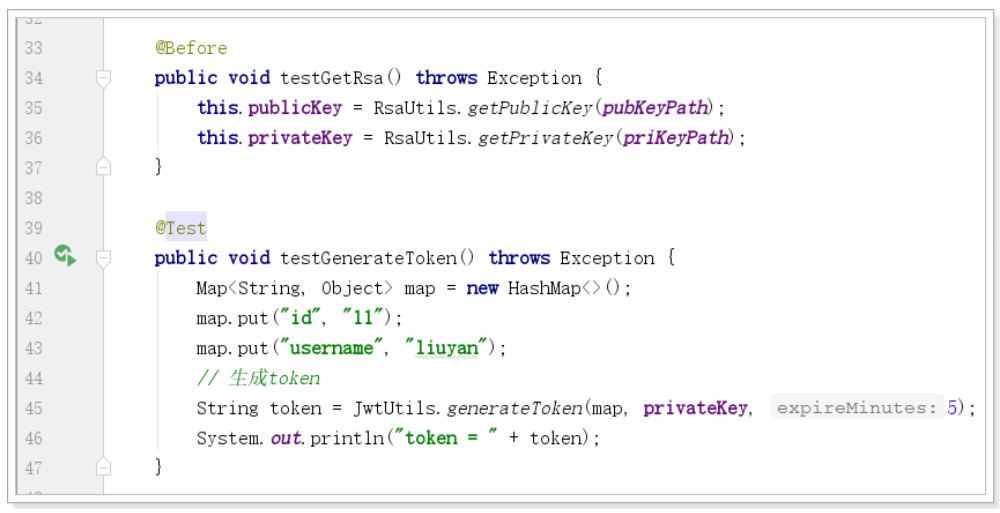搭建授权中心

用户鉴权:
-
接收用户的登录请求,通过用户中心的接口进行校验,通过后生成JWT
-
使用私钥生成JWT并返回
有一些生成jwt,解析jwt这样行为的工具类,以后在其它微服务中也会用到,因此放在gmall-core中。
JWT工具类
package com.leon.core.utils;
import io.jsonwebtoken.Claims;
import io.jsonwebtoken.Jws;
import io.jsonwebtoken.Jwts;
import io.jsonwebtoken.SignatureAlgorithm;
import io.jsonwebtoken.security.Keys;
import org.joda.time.DateTime;
import java.security.PrivateKey;
import java.security.PublicKey;
import java.util.Map;
public class JwtUtils {
/**
* 私钥加密token
*
* @param map 载荷中的数据
* @param expireMinutes 过期时间,单位秒
* @return
* @throws Exception
*/
public static String generateToken(Map<String, Object> map, PrivateKey key, int expireMinutes) throws Exception {
return Jwts.builder()
.setClaims(map)
.setExpiration(DateTime.now().plusMinutes(expireMinutes).toDate())
.signWith(key, SignatureAlgorithm.RS256)
.compact();
}
/**
* 公钥解析token
*
* @param token 用户请求中的token
* @return
* @throws Exception
*/
private static Jws<Claims> parserToken(String token, PublicKey key) {
return Jwts.parser().setSigningKey(key).parseClaimsJws(token);
}
/**
* 获取token中的用户信息
*
* @param token 用户请求中的令牌
* @return 用户信息
* @throws Exception
*/
public static Map<String, Object> getInfoFromToken(String token, PublicKey key) throws Exception {
Jws<Claims> claimsJws = parserToken(token, key);
return claimsJws.getBody();
}
}package com.leon.core.utils;
import java.io.File;
import java.io.IOException;
import java.nio.file.Files;
import java.security.*;
import java.security.spec.PKCS8EncodedKeySpec;
import java.security.spec.X509EncodedKeySpec;
public class RsaUtils {
/**
* 从文件中读取公钥
*
* @param filename 公钥保存路径,相对于classpath
* @return 公钥对象
* @throws Exception
*/
public static PublicKey getPublicKey(String filename) throws Exception {
byte[] bytes = readFile(filename);
return getPublicKey(bytes);
}
/**
* 从文件中读取密钥
*
* @param filename 私钥保存路径,相对于classpath
* @return 私钥对象
* @throws Exception
*/
public static PrivateKey getPrivateKey(String filename) throws Exception {
byte[] bytes = readFile(filename);
return getPrivateKey(bytes);
}
/**
* 获取公钥
*
* @param bytes 公钥的字节形式
* @return
* @throws Exception
*/
public static PublicKey getPublicKey(byte[] bytes) throws Exception {
X509EncodedKeySpec spec = new X509EncodedKeySpec(bytes);
KeyFactory factory = KeyFactory.getInstance("RSA");
return factory.generatePublic(spec);
}
/**
* 获取密钥
*
* @param bytes 私钥的字节形式
* @return
* @throws Exception
*/
public static PrivateKey getPrivateKey(byte[] bytes) throws Exception {
PKCS8EncodedKeySpec spec = new PKCS8EncodedKeySpec(bytes);
KeyFactory factory = KeyFactory.getInstance("RSA");
return factory.generatePrivate(spec);
}
/**
* 根据密文,生存rsa公钥和私钥,并写入指定文件
*
* @param publicKeyFilename 公钥文件路径
* @param privateKeyFilename 私钥文件路径
* @param secret 生成密钥的密文
* @throws IOException
* @throws NoSuchAlgorithmException
*/
public static void generateKey(String publicKeyFilename, String privateKeyFilename, String secret) throws Exception {
KeyPairGenerator keyPairGenerator = KeyPairGenerator.getInstance("RSA");
SecureRandom secureRandom = new SecureRandom(secret.getBytes());
keyPairGenerator.initialize(2048, secureRandom);
KeyPair keyPair = keyPairGenerator.genKeyPair();
// 获取公钥并写出
byte[] publicKeyBytes = keyPair.getPublic().getEncoded();
writeFile(publicKeyFilename, publicKeyBytes);
// 获取私钥并写出
byte[] privateKeyBytes = keyPair.getPrivate().getEncoded();
writeFile(privateKeyFilename, privateKeyBytes);
}
private static byte[] readFile(String fileName) throws Exception {
return Files.readAllBytes(new File(fileName).toPath());
}
private static void writeFile(String destPath, byte[] bytes) throws IOException {
File dest = new File(destPath);
if (!dest.exists()) {
dest.createNewFile();
}
Files.write(dest.toPath(), bytes);
}
}并在core的pom.xml中引入新的依赖:
<dependency>
<groupId>io.jsonwebtoken</groupId>
<artifactId>jjwt-api</artifactId>
<version>0.10.6</version>
</dependency>
<dependency>
<groupId>io.jsonwebtoken</groupId>
<artifactId>jjwt-impl</artifactId>
<version>0.10.6</version>
</dependency>
<dependency>
<groupId>io.jsonwebtoken</groupId>
<artifactId>jjwt-jackson</artifactId>
<version>0.10.6</version>
<scope>runtime</scope>
</dependency>
<dependency>
<groupId>joda-time</groupId>
<artifactId>joda-time</artifactId>
<version>2.10.3</version>
</dependency>测试工具类
public class JwtTest {
private static final String pubKeyPath = "C:\tmp\rsa\rsa.pub";
private static final String priKeyPath = "C:\tmp\rsa\rsa.pri";
private PublicKey publicKey;
private PrivateKey privateKey;
@Test
public void testRsa() throws Exception {
RsaUtils.generateKey(pubKeyPath, priKeyPath, "234");
}
@Before
public void testGetRsa() throws Exception {
this.publicKey = RsaUtils.getPublicKey(pubKeyPath);
this.privateKey = RsaUtils.getPrivateKey(priKeyPath);
}
@Test
public void testGenerateToken() throws Exception {
Map<String, Object> map = new HashMap<>();
map.put("id", "11");
map.put("username", "liuyan");
// 生成token
String token = JwtUtils.generateToken(map, privateKey, 5);
System.out.println("token = " + token);
}
@Test
public void testParseToken() throws Exception {
String token = "eyJhbGciOiJSUzI1NiJ9.eyJpZCI6IjExIiwidXNlcm5hbWUiOiJsaXV5YW4iLCJleHAiOjE1NzAxMjEyODZ9.GioCiqMt_ZcN6_RAuDBcOzcHQ5WdqdhA9QYu-2IqCQqnAef1VyXczEInj1Ef1xo7AvcjxnkIMuZK48OoczUy1iqtPQPDchUzTl03b8h_J3xMBaxOAaKSwMpm20DH25VrTgBExUafyxHwxfOa-PVHW0Kk41KrWDncayzXbZ_lYLoa9Cuvacr8eAFz-ckriIiZ9bRzFkhX-wYHSHFlym2IJRjBRhFtpkN5GLAVsmsdm-yD4eiJXqioWspqXiBSdROsjrTRiFe511yujR0y2ngL9OnZ1QH6bHDQ2WmhPTrswKjjy-HWIxk1FQ7uXtSpPa5diymmPVTWA0clys7R1MK9oQ";
// 解析token
Map<String, Object> map = JwtUtils.getInfoFromToken(token, publicKey);
System.out.println("id: " + map.get("id"));
System.out.println("userName: " + map.get("username"));
}
}测试生成公钥和私钥,我们运行这段代码:**注意需要把@Before方法注释掉

运行之后,查看目标目录:

测试生成token,把@Before的注释去掉的:

测试解析token:

正常情况:

任意改动一下:

最后
以上就是洁净柜子最近收集整理的关于jwt工具类介绍搭建授权中心的全部内容,更多相关jwt工具类介绍搭建授权中心内容请搜索靠谱客的其他文章。
本图文内容来源于网友提供,作为学习参考使用,或来自网络收集整理,版权属于原作者所有。








发表评论 取消回复